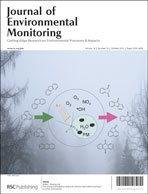Bioremediation of polluted soil through the combined application of plants, earthworms and organic matter
Abstract
Two plant species (Paulownia tomentosa and Cytisus scoparius), earthworms (Eisenia fetida), and organic matter (horse manure) were used as an ecological approach to bioremediate a soil historically contaminated by heavy metals and hydrocarbons. The experiment was carried out for six months at a mesoscale level using pots containing 90 kg of polluted soil. Three different treatments were performed for each plant: (i) untreated planted soil as a control (C); (ii) planted soil + horse manure (20 : 1 w/w) (M); (iii) planted soil + horse manure + 15 earthworms (ME). Both the plant species were able to grow in the polluted soil and to improve the soil's bio-chemical conditions, especially when organic matter and earthworms were applied. By comparing the two plant species, few significant differences were observed in the soil characteristics; Cytisus scoparius improved soil nutrient content more than Paulownia tomentosa, which instead stimulated more soil microbial metabolism. Regarding the pollutants, Paulownia tomentosa was more efficient in reducing the heavy metal (Pb, Cr, Cd, Zn, Cu, Ni) content, while earthworms were particularly able to stimulate the processes involved in the decontamination of organic pollutants (hydrocarbons). This ecological approach, validated at a mesoscale level, has recently been transferred to a real scale situation to carry out the bioremediation of polluted soil in San Giuliano Terme Municipality (Pisa, Italy).


 Please wait while we load your content...
Please wait while we load your content...